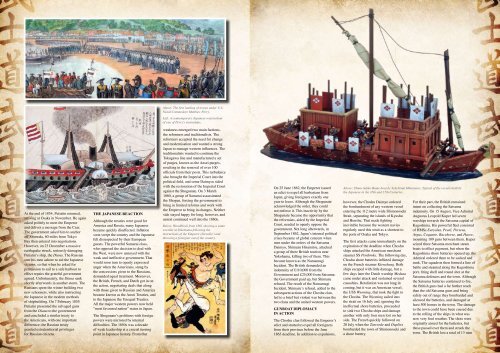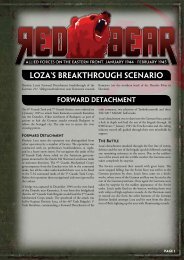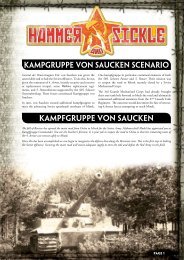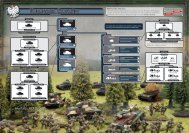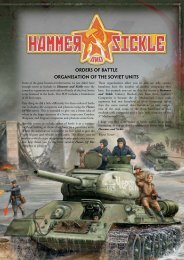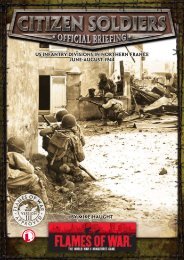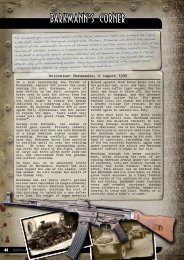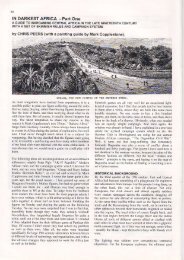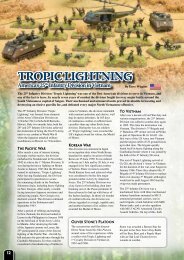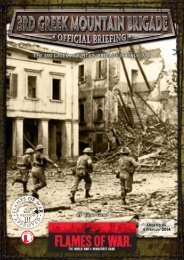Download a PDF version of this article here... - Flames of War
Download a PDF version of this article here... - Flames of War
Download a PDF version of this article here... - Flames of War
- No tags were found...
You also want an ePaper? Increase the reach of your titles
YUMPU automatically turns print PDFs into web optimized ePapers that Google loves.
Napoleonic <strong>War</strong>s1803-1815Above: The first landing <strong>of</strong> troops under U.S.Naval Commodore Matthew Perry.Left: A comtemporary Japanese watercolour<strong>of</strong> one <strong>of</strong> Perry’s steamships.At the end <strong>of</strong> 1854, Putiatin returned,arriving at Osaka in November. He againasked politely to meet the Emperorand deliver a message from the Czar.The government asked him to anchor<strong>of</strong>f Shimoda, 60 miles from TokyoBay then entered into negotiations.However, on 23 December a massiveearthquake struck, seriously damagingPutiatin’s ship, the Diana. The Russiansent his men ashore to aid the Japanesevictims, so that when he asked forpermission to sail to a safe harbour toeffect repairs the grateful governmentagreed. Unfortunately, the Diana sankshortly afterwards in another storm. TheRussians spent the winter building twonew schooners, while also instructingthe Japanese in the modern methods<strong>of</strong> shipbuilding. On 7 February 1855Putiatin presented the salvaged gunsfrom the Diana to the governmentand concluded a similar treaty tothe Americans, with one importantdifference; the Russian treatygranted extraterritorial privilegesfor Russian citizens.The Japanese ReactionAlthough the treaties were good forAmerica and Russia, many Japanesebecame quickly disaffected. Inflationsoon swept the country and the Japanesefelt disrespected by their Europeanguests. The powerful Samurai class,who opposed the decision to deal withthe West, were now annoyed with theweak and ineffective government. Thatwould soon turn to openly expressedanger when the Americans, stung bythe concessions given to the Russians,demanded equal treatment. Moreover,the British, French, and Dutch got in onthe action, negotiating deals that alongwith those given to Russian and Americabecame known as the Ansei Treaties, andto the Japanese the Unequal Treaties.All the major western powers now held“most favoured nation” status in Japan.The Shogunate’s problems with foreignpowers were mirrored by internaldifficulties. The 1850s was a decade<strong>of</strong> weak leadership at a crucial turningpoint in Japanese history. From thatweakness emerged two main factions,the reformers and traditionalists. T<strong>here</strong>formers accepted the need for changeand modernisation and wanted a strongJapan to manage western influences. Thetraditionalists wanted to continue theTokugawa line and manufactured a set<strong>of</strong> purges, known as the Ansei purges,resulting in the removal <strong>of</strong> over 100<strong>of</strong>ficials from their posts. This turbulencealso brought the Imperial Court into thepolitical field, and some Daimyos sidedwith the restoration <strong>of</strong> the Imperial Courtagainst the Shogunate. On 3 March1860, a group <strong>of</strong> Samurai assassinatedthe Shogun, forcing the government tobring in limited reforms and work withthe Emperor to bring in changes. Neitherside stayed happy for long, however, andunrest continued well into the 1860s.Below: Woodblock from 1861 showing a sumowrestler at Yokohama following theinstructions <strong>of</strong> the Emperor (literally!) andthrowing a foreigner out <strong>of</strong> the country.On 25 June 1862, the Emperor issuedan edict to expel all barbarians fromJapan, giving foreigners exactly oneyear to leave. Although the Shogunateacknowledged the order, they couldnot enforce it. This inactivity by theShogunate became the opportunity thatthe reformists, aided by the ImperialCourt, needed to openly oppose thegovernment. Not long afterwards, inSeptember 1862, Japan’s internal politicalcrises became <strong>of</strong> global concern whenmen under the orders <strong>of</strong> the SatsumaDaimyo, Shimazu Hisamitsu, attackeda group <strong>of</strong> three British tourists nearYokohama, killing two <strong>of</strong> them. Thisbecame known as the NamamugiIncident. The British demanded anindemnity <strong>of</strong> £110,000 from theGovernment and £25,000 from Satsuma:the Government paid up, but Shimazurefused. The result <strong>of</strong> the NamamugiIncident, Shimazu’s refusal, added to thesubsequent actions <strong>of</strong> the Choshu clan,led to a brief but violent war between thetwo clans and the united western powers.Gunboat Diplomacyin ActionThe Choshu clan followed the Emperor’sedict and started to expel all foreignersfrom their province before the June1863 deadline. In addition to expulsions,Above: 28mm Adake-Bume boat by Scheltrum Miniatures. Typical <strong>of</strong> the vessels built bythe Japanese in the 16th and 17th Centuries.however, the Choshu Daimyo orderedthe bombardment <strong>of</strong> any western vesselentering the 112 metre wide ShimonosekiStrait, separating the islands <strong>of</strong> Kyushuand Honshu. That made fightinginevitable because the western naviesregularly used <strong>this</strong> strait as a shortcut tothe ports <strong>of</strong> Osaka and Tokyo.The first attacks came immediately on theexpiration <strong>of</strong> the deadline when Choshuships attacked the American merchantsteamer SS Pembroke. The following day,Choshu shore batteries inflicted damageon the French steamer Kienchang. Bothships escaped with little damage, but afew days later the Dutch warship Medusacame under attack and sustained severalcasualties. Retaliation was not long incoming, but it was an American vessel,the USS Wyoming, that took the fight tothe Choshu. The Wyoming sailed intothe strait on 16 July and, ignoring theineffectual shore batteries, proceededto sink two Choshu ships and damageanother with only four men lost on herside. The French quickly followed on20 July when the Tancrede and Dupliexbombarded the town <strong>of</strong> Shimonoseki anda shore battery.For their part, the British remainedintent on collecting the Satsumaindemnity. On 15 August, Vice AdmiralAugustus Leopold Kuper led sevenwarships towards the Satsuma capital <strong>of</strong>Kagoshima. His powerful fleet consisted<strong>of</strong> HMSs Euryalus, Pearl, Perseus,Argus, Coquette, Racehorse, and Havoc,mounting 109 guns between them. Kuperseized three Satsuma merchant steamboats to effect payment, but when theKagoshima shore batteries opened up, theAdmiral ordered them to be sacked andsunk. The squadron then formed a line <strong>of</strong>battle and steamed along the Kagoshimaport, firing shell and round shot at theSatsuma defences and the town. Althoughthe Satsuma batteries continued to fire,the British guns had a far further reachthan the old Satsuma guns and beingsafely out <strong>of</strong> range they bombarded andsilenced the batteries, and damaged atleast 500 homes in the town. The damageto the town could have been caused dueto the rolling <strong>of</strong> the ships in what wasnow very foul weather. The shots wereoriginally aimed for the batteries, butthese passed over them and struck thetown. The British lost a total <strong>of</strong> 13 men


